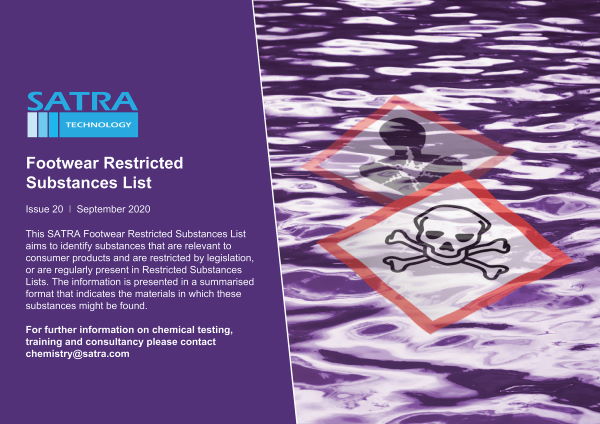New SATRA RSL available
Issue 20 contains essential information for footwear producers.
by Martin Heels

The SATRA Footwear Restricted Substances List (RSL) is published twice each year, and the latest edition of this important document – issue 20 – is now available to SATRA members. This publication contains information about the restricted substances that are applicable to materials typically used in footwear. The key change for issue 20 is the inclusion of relevant substances from the revised Persistent Organic Pollutants (POP) Regulation (EU) 2019/1021.
The original POP Regulation – (EC) No.850/2004 – was substantially amended several times, so a recast regulation was created in 2019 for the purposes of clarity. A key objective of the POP Regulation remains to restrict the release of dangerous chemicals into the environment. As the regulation’s name suggests, this group of chemicals persist in the environment as they have a high resistance to chemical and biological degradation.
As a consequence, they can be a danger to human health or to the environment for a long time after they are released. Some pesticides and industrial chemicals fall into this category. Pesticides are relevant to natural materials such as leather, cotton and wool, although their presence in final articles are likely to be low risk.
Industrial chemicals include brominated flame retardants, perfluorooctane sulphonic acid (PFOS) and pentachlorophenol (PCP). The full lists of pesticides and industrial chemicals are included in appendices 8a and 8b of the updated Footwear RSL.

The SATRA Footwear Restricted Substances List contains information about the restricted substances that are applicable to materials typically used in footwear
The SATRA Footwear RSL summarises the restricted substances in REACH Regulation (EC) No.1907/2006 Annex XVII relevant to footwear materials. The most recent REACH Annex XVII list was published on 10th August 2020 and contains 74 entries. These have been considered when collating information for our restricted substances lists, along with legislation in the USA and national legislation within European countries.
SATRA’s ISO 17025-accredited chemical testing laboratory routinely tests footwear, footwear components, leathergoods and other consumer products for the presence of restricted substances. This testing can be conducted on materials before articles are produced, or we can test samples from bulk production. Once testing has been completed, results can be reported against the legislative requirements, or against individual brand owner’s or retailers’ specifications, depending on our customer’s request.
How can we help?
We also offer consultancy services and training to aid understanding of restricted substances and the REACH legislation. Free webinars (including recordings of past events) can be accessed at www.satra.com/resources and a downloadable version of the RSL is available from the members-only area of the SATRA website (www.satra.com/members). Please email chemistry@satra.com for further information.
Publishing Data
This article was originally published on page 34 of the October 2020 issue of SATRA Bulletin.
Other articles from this issue »


 EN
EN ZH
ZH